
Joycelyn Longdon is a first year PhD student currently researching the application of artificial intelligence to climate change at Cambridge University. As a diasporic woman of color, Joycelyn says she cannot see climate justice without racial and social justice. Her work in the tech and science space focuses on centering indigenous knowledge systems and marginalized voices in algorithms.
When Joycelyn was accepted onto her course, she founded Climate In Colour, a platform aimed at giving space to the voices she felt were being ignored in the mainstream climate conversation. She hopes that this space will make climate science and environmental issues more accessible and diverse.
For more information, please visit https://www.climateincolour.com/about

Image: @climateincolour on Instagram
We spoke with Joycelyn recently about her work and activism.
ClimateMusic: Can you tell us a bit more about the inspiration behind your organization Climate In Colour? What did you hope to achieve when you founded it? Has this shifted at all since its creation last year?
JL: I started CIC shortly after I was accepted onto my current postgraduate degree course. I had no intention for it to become a large platform, rather it was a space that could act both as a creative outlet for me, as someone who is both deeply scientific and creative, and to disseminate information about the climate crisis and its intersections with oppression which are either hidden away behind academic paywalls or not spoken about at all.
In general, nothing has changed about the mission. I want to make climate conversations more diverse and accessible and, with the help of my amazing team, I think we are delivering on this! The biggest shift has definitely been the refocussing and doubling down on building a community, focusing on connection and creating space for nuance. I do so much work off of social media for CIC, and these are the spaces – whether online courses, webinars or team days – where I have seen the most change and critical thinking occur.
ClimateMusic: How did your interest in climate change begin and why did you decide to incorporate climate topics into your work with artificial intelligence?
JL: I went to my first environmental march at 16, but shortly after, became disillusioned by the movement as I was made to feel that climate change wasn’t my problem, the community wasn’t my community and that I need to jump through so many hurdles to be granted real entry into the space. I wasn’t aware of the intersections between race and climate at the time and doubled down on my activism in the diversity and anti-racism spaces, namely through starting BlackOnBlack. However, I returned to the movement after educating myself and discovering all the ways oppression of my community, indigenous folks, Asian folks, trans folks, marginalised people, in general, was linked to the climate emergency and my mind was blown. Once I started reading, watching and listening, I couldn’t stop and became filled with motivation and determination to be part of the change and disrupt the space.
As far as my degree goes, as a low-income teenager, I never thought I would be able to do further study, I was also skeptical about the way I would be received as a Black woman entering further into the academic world. However, when I saw the course (AI4ER) and saw that it was funded, my mind started whirring with ideas. My first degree was in Astrophysics and that was accepted on the course so it made sense, it was also funded! I have learned so much in the last 6 months and I couldn’t have imagined what the course would have been like before I started, all I knew is that I felt drawn to accept my place and that it posed an opportunity to make real change; I just needed to figure out how.ClimateMusic: When most people think of technology, they see it as completely separate from nature and the environment. How would you describe the relationship between technology and environmentalism?
JL: Our modern-day definitions of technology centre on objects such computers, of metal electronic things which seem incongruent with our soft, green leafy ideas around nature. Yet, when we consider concepts such as Lo-Tek, introduced by Julia Watson who argues that highlights the fact that tribal communities, seen by many as primitive, are highly advanced when it comes to creating systems in symbiosis with the natural world, I think we get a more holistic view of what technology really is. The evidence is all around us, from Incan rope suspension bridges or the ancient homes of Yemen which are now inspiring modern “technological” solutions to construction waste in home construction. This is all to say that it is only our modern, capital driven, scale obsessed, oppressive and destructive forms of technology that are blatantly at odds with the environment and the people that live within it. Technology, that has intention, that is co-created, that is sympathetic to the environment and works in collaboration with the rest of nature, rather than seeing it as a resource to be exploited and that centres the narratives, voices and knowledge of marginalised groups is the kind of technology we should be making.
ClimateMusic: The same can generally be said for technology and humanity. How does your work in AI incorporate complex human-centric topics like indigenous knowledge and social sciences?
JL: There has been a long-standing acrimonious relationship between the beliefs and practices of traditional communities and those of formal science and technology which has resulted in disrespect for traditional practices and erasure of indigenous knowledge. It’s also important to note, quickly, that Indigenous knowledge isn’t just traditional knowledge, Indigenous knowledge is science too and I think that sometimes there is this paternalistic view that pigeon holes indigenous communities as this monolith group of people who only engage in certain practices or fields.
My work (which will formally start in September) will follow a DEcolonising Methodologies approach as well as a Community Citizen Science approach that positions indigenous belief systems as an integral part of research and embraces participatory democracy, community co-design and power re-balance. My work will focus hugely on the co-design of methods and approaches with communities in order to develop interactive systems in collaboration with communities that are embedded in local culture and systems.
ClimateMusic: What does accessibility in education mean to you? How can scientists and other organizations work towards making information on climate change more accessible?
JL: Accessibility in any field, not just education is essential. People have a right to have access to the information they need to make informed decisions and be better allies, citizens and people. This doesn’t just mean simplifying concepts, this means adjusting tone, design, graphics, visuals, medium and price for a diverse range of people who have a diverse range of circumstances.
ClimateMusic: What has the impact of Climate In Colour been so far? What are your goals for the future?
JL: Of course, there are all the vanity metrics: 22.6k followers on IG, 1k+ newsletter subscribers, 50 private community members, 1k YouTube followers and collaborations, talks and events with Fairtrade, Oxford University, The Wellcome Collection, Dazed Magazine and The DEsign Musueam.
Of course, there has been impact, but I think people get too distracted by this sort of impact. I am so grateful to have been able to connect with and connect so many amazing people and organisations but the real impact and the most pleasure I get from running climate in colour is all the intense, respectful, challenging conversations I have on webinars and teach-ins I host for other organisations and in my own private community. I feel such deep healing with these conversations, in all directions and am so happy to be able to take up space and give space to shift climate narratives. I am also super proud to have made an impact on communities that have previously not had the most accessible engagement with climate topics.
I get as much out of CimateInColour as I give out and the impact on my own life has been huge in the way I communicate myself, the boundaries I set, the amount I push myself and how committed and dedicated I am and feel to my purpose in the climate movement.ClimateMusic: What advice would you give to someone who wants to start getting involved in climate action?
JL: Start now. Ignore the gatekeepers. Find your purpose, and read this post.
ClimateMusic: Where can we learn more about the work that you’re doing?
JL: You can sign up for our online courses on the website, we have just released a brand new one, Just Food: Security vs Sovereignty!
You can join the reading group in our private online community where we have nuanced conversations and also provide exclusive content: https://www.patreon.
ClimateMusic: Thank you for talking with us